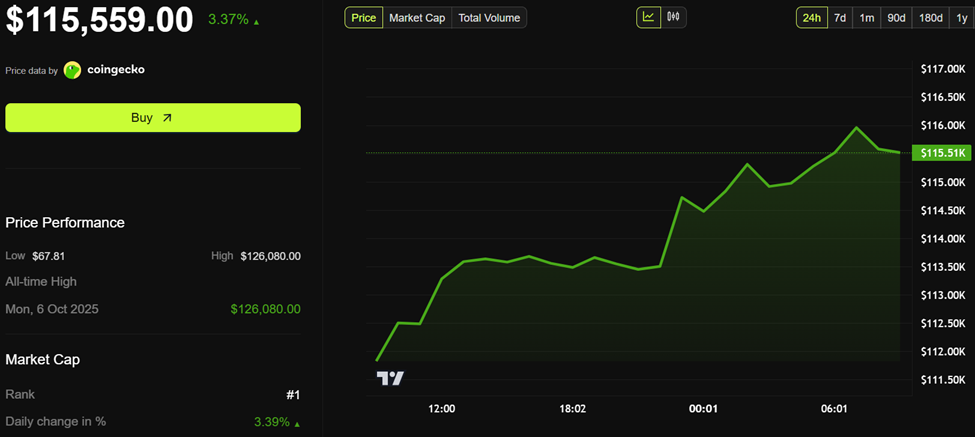Another Year, Another Delay: Mt. Gox Keeps $4 Billion in Bitcoin Off the Market
Bitcoin rallied past $115,000 after Mt. Gox postponed its long-awaited creditor repayments by another year. The defunct exchange will now hold its 34,689 BTC until October 2026, easing market pressure and pushing BTC toward fresh highs.
Mt. Gox’s prolonged repayment saga extends into 2026, keeping 34,000 BTC off the market and easing near-term sell pressure.
The move delays what would have been a supply shock to the Bitcoin market for the third time. It was initially set for October 31, 2023, and October 2025 after that.
Mt. Gox Repayment Extension Eases Immediate Bitcoin Sell-Off Fears
Bitcoin rose nearly 4% in the past 24 hours to trade at $115,559 as of press time. The move follows Mt. Gox again, delaying its long-awaited creditor repayments by another year, now set for October 31, 2026.
INTEL: Mt. Gox has delayed creditor repayments by another year, now due Oct 2026. The exchange still holds 34,689 BTC awaiting distribution.
— Solid Intel 📡 (@solidintel_x)
A Japanese court authorized the decision, meaning roughly 34,689 BTC will remain locked away for at least another twelve months. This limits the immediate risk of a large-scale selloff.
 Bitcoin (BTC) Price Performance. Source:
Bitcoin (BTC) Price Performance. Source:
The new notice, dated October 27, 2025, from rehabilitation trustee Nobuaki Kobayashi, explains that while “repayments to eligible creditors are largely completed,” many cases remain unresolved due to incomplete procedures and administrative issues.
“It has become desirable to make the repayments to such rehabilitation creditors to the extent reasonably practicable,” Kobayashi stated in the letter, citing court approval for the one-year extension.
Legal Delays and Lingering Fallout
The extension highlights the lingering technicalities of the 2014 Mt. Gox collapse. Hackers stole around 850,000 BTC worth $450 million from what was once the world’s largest Bitcoin exchange.
Over 127,000 users have awaited compensation for over a decade, as legal proceedings and asset recovery efforts dragged on. Blockchain data still shows the exchange’s wallets holding 34,689 untouched BTC, valued at over $4 billion at current prices.
 Mt. Gox BTC. Source:
Mt. Gox BTC. Source:
According to BeInCrypto’s earlier reporting, Mt. Gox wallets recently showed movement for the first time in seven months, fueling speculation about test transfers ahead of distributions.
Analysts noted that similar activity in the past preceded repayment events. However, the latest development regarding a one-year delay assuages the market and serves as a stabilizing event for Bitcoin.
CryptoQuant analyst Mignolet previously warned that if the trustee fails to secure further extensions, the eventual release of 34,000 BTC could “become a catalyst for creating FUD once again.” This has now been avoided.
Mt. Gox pushes repayments to 2026!Say goodbye to immediate sell-off fears!Market breathing room just got extended.
— 𝐊𝐚𝐦𝐫𝐚𝐧 𝐀𝐬𝐠𝐡𝐚𝐫 (@Karman_1s)
The fears abounded as weakening liquidity in OTC (over-the-counter) markets raised concerns. Unlike last year, that volume is now weakening, raising uncertainty about whether the market could absorb 34,000 Bitcoins at once as it did before.
Disclaimer: The content of this article solely reflects the author's opinion and does not represent the platform in any capacity. This article is not intended to serve as a reference for making investment decisions.
You may also like
$8.8 billion outflow countdown: MSTR is becoming the abandoned child of global index funds
The final result will be revealed on January 15, 2026, and the market has already started to vote with its feet.

Deconstructing DAT: Beyond mNAV, How to Identify "Real vs. Fake HODLing"?
There is only one iron rule for investing in DAT: ignore premium bubbles and only invest in those with a genuine flywheel of continuously increasing "crypto per share."

Empowered by AI Avatars, How Does TwinX Create Immersive Interaction and a Value Closed Loop?
1. **Challenges in the Creator Economy**: Web2 content platforms suffer from issues such as opaque algorithms, non-transparent distribution, unclear commission rates, and high costs for fan migration, making it difficult for creators to control their own data and earnings. 2. **Integration of AI and Web3**: The development of AI technology, especially AI Avatar technology, combined with Web3's exploration of the creator economy, offers new solutions aimed at breaking the control of centralized platforms and reconstructing content production and value distribution. 3. **Positioning of the TwinX Platform**: TwinX is an AI-driven Web3 short video social platform that aims to reconstruct content, interaction, and value distribution through AI avatars, immersive interactions, and a decentralized value system, enabling creators to own their data and income. 4. **Core Features of TwinX**: These include AI avatar technology, which allows creators to generate a learnable, configurable, and sustainably operable "second persona", as well as a closed-loop commercialization pathway that integrates content creation, interaction, and monetization. 5. **Web3 Characteristics**: TwinX embodies the assetization and co-governance features of Web3. It utilizes blockchain to confirm and record interactive behaviors, turning user activities into traceable assets, and enables participants to engage in platform governance through tokens, thus integrating the creator economy with community governance.

Aster CEO explains in detail the vision of Aster privacy L1 chain, reshaping the decentralized trading experience
Aster is set to launch a privacy-focused Layer 1 (L1) public chain, along with detailed plans for token empowerment, global market expansion, and liquidity strategies.

